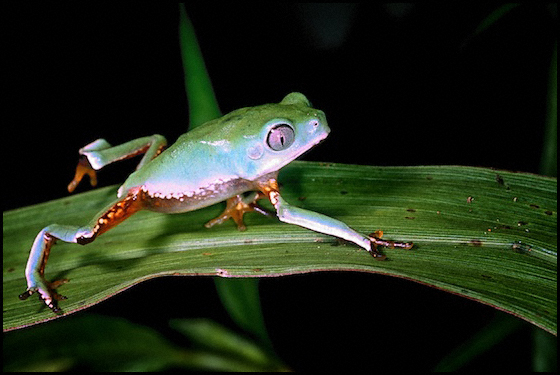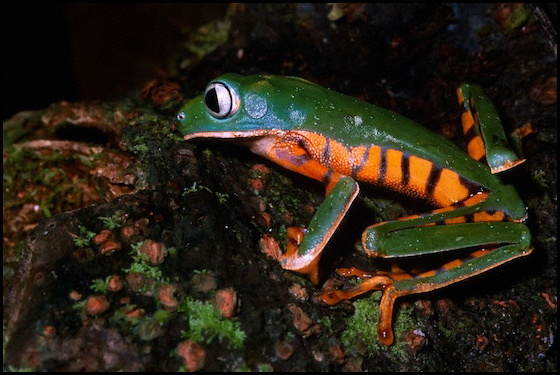Phyllomedusinae – of monkeys and frogs

A juvenile Phyllomedusa bicolor walks across a leaf near the city of Iquitos, Peru. Despite being fairly common this is my only sighting of this frog.
And now we return to South America. Half of the subfamily species reside in the genus Phyllomedusa, and like I mentioned previously, most of those are in Brazil. But there are some wonderful representations in western Amazonia where I tend to spend my time. And one of those is known well enough that even non-herp people mention it – even if they don’t know the species. Most frog people will get an inquiry from a curious friend or family member about which frogs you lick to get high. Well, that semi-urban myth comes from a couple potential species and Phyllomedusa bicolor is one of them. The Peruvian Matses tribe has used the bioactive peptides found in the skin of this frog for hunting rituals. Waxy secretions from the frog are rubbed into a freshly burned wound where they are quickly taken into the bloodstream. The initial effects are generally vomiting and diarrhea but soon thereafter there appears to be a heightened sensory alertness. The increased energy and suppression of hunger allows hunters to range farther, faster, and longer on extended hunts when local prey is no longer available. There have been numerous studies on this frog and its pharmacological biology. I saw my first when Steve Waldron and I were in Peru. We were spending a week in the forests around Iquitos before heading out on a memorable Greentracks trip where several more first discoveries would occur. I was tracking the calls of some Hypsiboas cinerascens when Steve found a juvenile Phyllomedusa bicolor. My first and only of that species.
Another species that is known for its skin secretions is the common pet species P. sauvagii. This frog resides in hot dry savanna forests and rests high up in sundrenched canopy. It is known to use its hind legs to wipe a waxy secretion all over the body completely covering itself in a waterproof cocoon. The barrier helps keep the porous frog skin from losing any moisture and protects from the desiccating rays of the sun. Unfortunately, I have not seen this frog in the wild.

An intensely colored specimen of a Peruvian Phyllomedusa tomopterna shows why they are called tiger-leg monkey frogs.
And then there were my encounters with P. tomopterna, the tiger-leg monkey frog, in Peru and Ecuador. This widespread species covers much of Amazonia and beyond, reaching the northeastern Atlantic shores of South America. I have seen gaudily bright specimens and a couple a bit more subdued. Phyllomedusa tomopterna closely resembles P. hypochondrialis, a common species in the pet trade. Phyllomedusa tomopterna and P. hypochondrialis have a good portion of their ranges overlapping but P. hypochondrialis extends further eastward and southward on the continent. All of the species in Phyllomedusa lay their eggs overhanging ponds on leaves but fold the leaves to help hide and secure the clutch during development. This behavior is only exhibited in Phyllomedusa and the genus Phasmahyla within the subfamily.

Another representative of Phyllomedusa tomopterna. This one is from Ecuador.







12 comments
Great post Tim! Loved the shots.
Beautiful; well done and very interesting.
Beautiful photos and wonderful information…Thanks for sharing your experiences with us Tim….
Tim, these are some of the most stunning photos of Phyllomedusinae I have yet to come across. Keep up the great work!!!..
Peter
Peter, thanks for the compliments. I’m trying. Waaaay behind on the blog work as I’ve given to some other writing assignments but hoping to tap out more in 2014.
Hello everyone , I’m Alanis.
Welcome to my homepage . I started writing in middle school after a creative writing assignment for my English teacher. I did creative writing for almost a year before I thought about doing something else.
I had always loved doing research assignments because I’m passionate about learning. When you combine writing skill with a love of learning, research paper writing only makes sense as a job.
I’m passionate about helping the students of the future in their school career. When they get too busy, I am there to help.
Alanis – Writing Expert – Greaternewarkcharterschool Corp
My name is Everly. And I am a professional Content writer with many years of experience in writing.
My main focus is to solve problems related to writing. And I have been doing it for many years. I have been with several groups as a volunteer and have assisted clients in many ways.
My love for writing has no end. It is like the air we breathe, something I cherish with all my being. I am a full-time writer who started at an early age.
I’m happy that I`ve already sold several copies of my works in different countries like Canada and China and others too numerous to mention.
I also work in an organization that provides assistance to many people from different parts of the world. Students always come to me because I work no matter how hard their projects are. I help them to save energy, because I feel happy when people come to me for writing help.
Academic Writer – Everly – //nametheschool.com/]Nametheschool Band
мостбет промокод – мелбет промокод при регистрации, 1хбет промокод на сегодня
Change Reach For The Sky Anthology https://nytimes.ysr.org.uk/38.html Avalon The Remixes Vol 2 Part One
Grapefruit can increase the amount of this medication in your bloodstream. Consult your doctor or pharmacist for more details.
site
q0uqn5
bp0n38